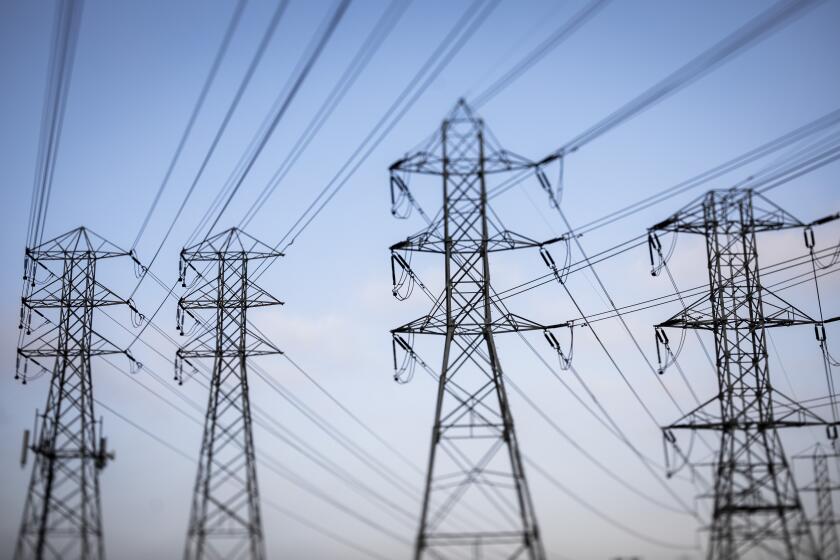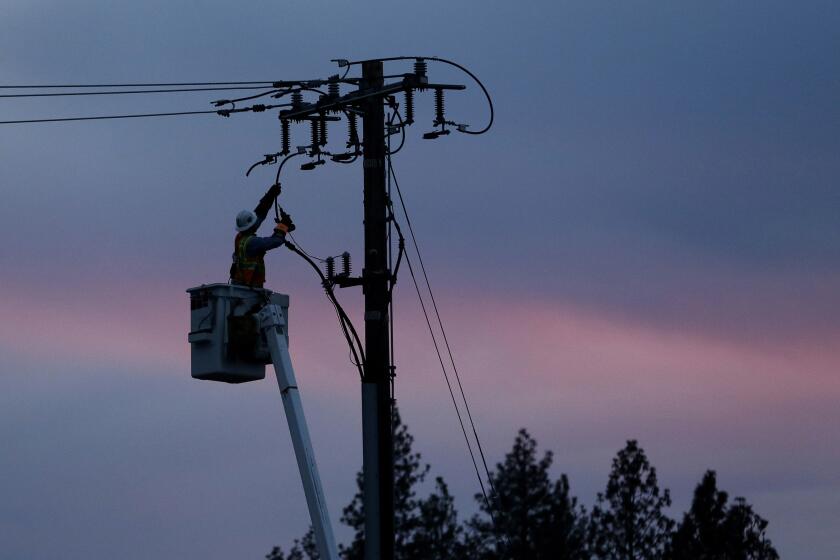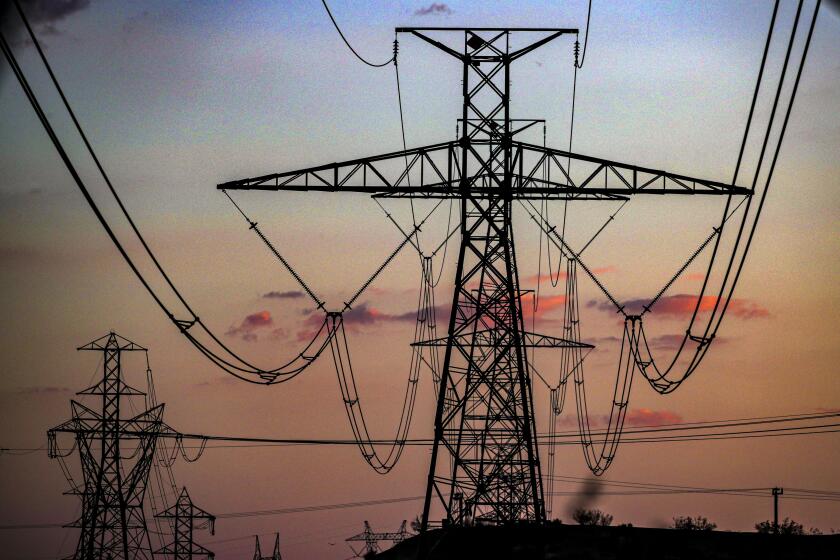California is changing how big power companies charge for electricity. What to expect on your bill

The dreariness of “May gray” hangs in the air, but soon enough people will be turning on their fans to fend off the heat. And as the temperature rises, so will electric bills.
As early as next year, though, the increase won’t be so pronounced for customers of Southern California Edison, San Diego Gas & Electric and Pacific Gas & Electric. At least, that’s the goal of a new approach to electricity rates adopted by the California Public Utilities Commission.
Your results, however, will depend on how much electricity you use. The change ordered by the CPUC will save money for Californians who pay hundreds of dollars a month for electricity, but it could be costly for people whose bills today are comparatively small.
In an effort to pare high electric bills during the summer heat, the CPUC adopted a utility-backed proposal to impose a flat monthly fee of up to $24.15 on all customers while reducing the charges imposed per kilowatt of electricity used. The order applies only to investor-owned utilities such as Edison, not to the Los Angeles Department of Water & Power and other municipal utilities.
The fee doesn’t represent new money for the utilities, said Mary Flannelly, policy and communications advisor for the CPUC’s independent Public Advocates Office. Instead, she said, it’s a cost that was historically baked into the utilities’ charge for each kilowatt a customer used.
It will now be a separate line item on the electric bill that every customer will have to pay.
The California Public Utilities Commission voted to fundamentally change how electricity is billed by adding a new monthly fixed fee.
On the usage portion of the bill, customers will see a cut of approximately 8% to 10%. According to the commission’s fact sheet, that translates to a reduction of about 5 cents to 7 cents per kilowatt hour for all residential customers.
The flat fee — which won’t be implemented until late 2025 or early 2026, depending on the utility — will be $24.15 for households not enrolled in a utility discount programs for qualified residents. The fee for low-income households enrolled in the California Alternate Rates for Energy discount program will be $6 a month, and the fee for households enrolled in the Family Electric Rate Assistance program will be $12. Customers living in affordable housing complexes whose household income is 80% or less of the area median will also pay $12 a month.
The revenue from the fee will go toward maintaining the electrical grid, preventing wildfires and funding energy-efficiency programs, officials have said.
This change was required by Assembly Bill 205, which modified energy-related regulations and programs to try to accelerate the state’s clean energy transition. Signed by Gov. Gavin Newsom in 2022, AB 205 sought to lower per-kilowatt charges to encourage customers to switch to electric appliances and vehicles.
“We commend the California Public Utilities Commission for taking action to ensure our state’s equitable transition to a clean energy future for all,” said Cynthia Martinez, spokesperson for the Predictable Power Coalition. “By voting to adopt the fixed charge, the CPUC took a critical step in the right direction towards modernizing the way we are charged for electricity, thereby reducing costs to the state’s most vulnerable families.”
The flat rate has been criticized by lawmakers and leaders of the Stop the Big Utility Tax coalition, who say fee will hurt customers who live in small homes and use less electricity.
With little public debate, state lawmakers passed a complex energy bill that upended how most Californians are billed for electricity.
Who are the winners and losers?
Customers who use a comparatively large amount of electricity every month will see the most benefits. “These include customers that live in hotter climate zones that use electricity for air conditioning, households with many residents and electric car owners,” Flannelly said.
Customers who use less electricity, households in cooler regions and houses with few occupants will tend to see bill increases.
If you’re a low energy user, your flat fee might add more to your bill than you’ll save from the lower usage rates, Flannelly said. If you use more energy and typically have a higher monthly bill, the rate reduction of 8% to 10% will save you more than the flat fee will add to your bill.
The obvious question for customers of the three investor-owned utilities is, how big does your electricity bill have to be in order to benefit from the change? And it’s surprisingly hard to get an answer to that question.
Assuming the fixed rate is offset solely by lower rates per kilowatt hour, if those rates go down by 10%, you won’t break even on the $24.15 fee over the course of a year unless you’re currently paying at least $241.50 a month on average for the kilowatts you use. If rates go down by 8%, you won’t break even on the $24.15 fee unless your average monthly usage charge today is at least $301.88.
For customers enrolled in the CARE discount program, the break-even point would be if their average monthly charge for electricity use was $60 to $75. For customers in the FERA program, the break-even point would be $120 to $150 in average monthly charges for electricity use.
“To be clear, this does not address the rates crisis Californians are facing, and we certainly don’t believe households can simply reduce consumption to avoid paying some of the highest rates in the country,” Flannelly said. The flat fee “is one tool to begin to address the rates crisis and we must do more.”
L.A. County residents are seeing an increase in their electric bills. Providers offer tips on how to reduce energy use and offer payment plans.
Tips on reducing your electric use
Whether you use a lot or a little electricity during the hot summer months, there are always ways you can reduce your usage and cut your bill.
One tip Flannelly shared is to avoid running larger electric-powered appliances such as washers, dryers and dishwashers during the times your utility imposes peak rates, typically between 4 to 9 p.m.
If you can, give your dryer a break and hang-dry your clothes.
“We understand that’s not always an option, but it’s one way to reduce,” she said.
Edison and other utilities advise you to try to avoid doing things that would heat up your home, which could cut down on your use of the air conditioner. For example, grill your food outdoors or use the microwave instead of turning on the stove.
If you do use the air conditioner, allow it to cool down your home, then open windows but keep the blinds closed to maintain the cool air.
PG&E recommends that customers replace their incandescent light bulbs with more efficient LEDs.
Another rule of thumb is to unplug electronics when they’re not in use. Or if they’re connected to a power strip, turn the strip off.
Set your thermostat to 78 degrees when you are home and to 85 degrees or “off” when you are away.
The California Public Utilities Commission suggests you charge your laptop, cellphone or tablets before 3 p.m. or after 9 p.m. when electricity rates are lower.
More to Read
Sign up for Essential California
The most important California stories and recommendations in your inbox every morning.
You may occasionally receive promotional content from the Los Angeles Times.














